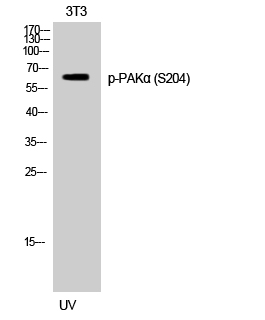Total PAK1 Cell-Based Colorimetric ELISA Kit
- Catalog No.:KA4217C
- Applications:ELISA
- Reactivity:Human;Mouse;Rat
- Gene Name:
- PAK1
- Human Gene Id:
- 5058
- Human Swiss Prot No:
- Q13153
- Mouse Swiss Prot No:
- O88643
- Rat Swiss Prot No:
- P35465
- Storage Stability:
- 2-8°C/6 months
- Other Name:
- Serine/threonine-protein kinase PAK 1 (EC 2.7.11.1) (Alpha-PAK) (p21-activated kinase 1) (PAK-1) (p65-PAK)
- Detection Method:
- Colorimetric
- Background:
- catalytic activity:ATP + a protein = ADP + a phosphoprotein.,cofactor:Magnesium.,enzyme regulation:Activated by binding small G proteins. Binding of GTP-bound CDC42 or RAC1 to the autoregulatory region releases monomers from the autoinhibited dimer, enables phosphorylation of Thr-423 and allows the kinase domain to adopt an active structure. Also activated by binding to GTP-bound CDC42, independent of the phosphorylation state of Thr-423. Phosphorylation of Thr-84 by OXSR1 inhibits this activation.,function:The activated kinase acts on a variety of targets. Likely to be the GTPase effector that links the Rho-related GTPases to the JNK MAP kinase pathway. Activated by CDC42 and RAC1. Involved in dissolution of stress fibers and reorganization of focal complexes. Involved in regulation of microtubule biogenesis through phosphorylation of TBCB. Activity is inhibited in cells undergoing apoptosis, potentially due to binding of CDC2L1 and CDC2L2.,PTM:Autophosphorylated when activated by CDC42/p21 and RAC1.,similarity:Belongs to the protein kinase superfamily. STE Ser/Thr protein kinase family. STE20 subfamily.,similarity:Contains 1 CRIB domain.,similarity:Contains 1 protein kinase domain.,subcellular location:Recruited to focal adhesions upon activation.,subunit:Homodimer in its autoinhibited state. Active as monomer. Interacts tightly with GTP-bound but not GDP-bound CDC42/P21 and RAC1. Binds to the caspase-cleaved p110 isoform of CDC2L1 and CDC2L2, p110C, but not the full-length proteins. Component of cytoplasmic complexes, which also contain PXN, ARHGEF6 and GIT1. Interacts with ARHGEF7. Also interacts with CRIPAK. Interacts with NISCH.,
- Function:
- MAPKKK cascade, regulation of protein amino acid phosphorylation, protein amino acid phosphorylation, phosphorus metabolic process, phosphate metabolic process, apoptosis, ER-nuclear signaling pathway, cytoskeleton organization,intracellular signaling cascade, protein kinase cascade, cell death, regulation of protein kinase cascade, programmed cell death, death, phosphorylation, regulation of phosphate metabolic process, regulation of protein modification process, regulation of cellular protein metabolic process, positive regulation of kinase activity, regulation of phosphorylation, positive regulation of catalytic activity, regulation of MAP kinase activity, positive regulation of MAP kinase activity, regulation of MAPKKK cascade, regulation of JUN kinase activity, positive regulation of JUN kinase activity, regulation of kinase activity, positive regulation of molecular function, regul
- Subcellular Location:
- Cytoplasm . Cell junction, focal adhesion . Cell projection, lamellipodium . Cell membrane . Cell projection, ruffle membrane . Cell projection, invadopodium . Nucleus, nucleoplasm . Chromosome . Cytoplasm, cytoskeleton, microtubule organizing center, centrosome . Colocalizes with RUFY3, F-actin and other core migration components in invadopodia at the cell periphery (PubMed:25766321). Recruited to the cell membrane by interaction with CDC42 and RAC1. Recruited to focal adhesions upon activation. Colocalized with CIB1 within membrane ruffles during cell spreading upon readhesion to fibronectin. Upon DNA damage, translocates to the nucleoplasm when phosphorylated at Thr-212 where is co-recruited with MORC2 on damaged chromatin (PubMed:23260667). Localization to the centrosome does not depen
- Expression:
- Overexpressed in gastric cancer cells and tissues (at protein level) (PubMed:25766321).
- June 19-2018
- WESTERN IMMUNOBLOTTING PROTOCOL
- June 19-2018
- IMMUNOHISTOCHEMISTRY-PARAFFIN PROTOCOL
- June 19-2018
- IMMUNOFLUORESCENCE PROTOCOL
- September 08-2020
- FLOW-CYTOMEYRT-PROTOCOL
- May 20-2022
- Cell-Based ELISA│解您多样本WB检测之困扰
- July 13-2018
- CELL-BASED-ELISA-PROTOCOL-FOR-ACETYL-PROTEIN
- July 13-2018
- CELL-BASED-ELISA-PROTOCOL-FOR-PHOSPHO-PROTEIN
- July 13-2018
- Antibody-FAQs

